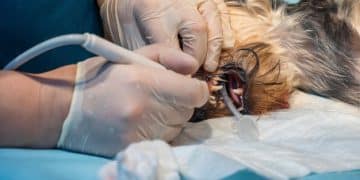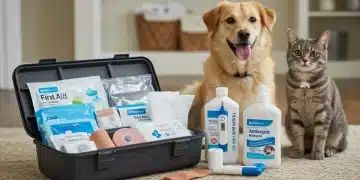Is Your Pet Drinking Enough Water? Preventing Dehydration & Kidney Issues
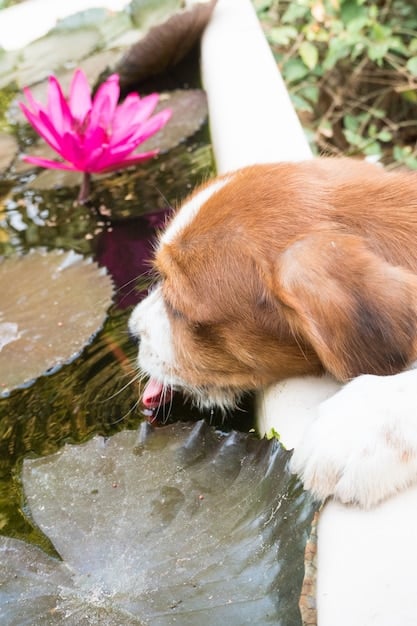
Ensuring your pet drinks enough water is crucial for their health, preventing dehydration and reducing the risk of kidney problems; learn how to encourage proper hydration.
Do you ever wonder if your furry friend is getting enough water? Just like humans, pets need adequate hydration to stay healthy. Is Your Pet Drinking Enough Water? How to Prevent Dehydration and Kidney Problems explores practical strategies to ensure your pet’s well-being, protecting them from dehydration and potential kidney issues.
Why Hydration Matters for Your Pet
Adequate hydration is essential for your pet’s overall health and well-being. Water plays a critical role in various bodily functions, from regulating temperature to aiding digestion and nutrient absorption.
When pets don’t drink enough water, they can suffer from dehydration, which can lead to serious health complications, including kidney problems.
The Role of Water in Your Pet’s Body
Water isn’t just a thirst quencher; it’s a vital component for maintaining physiological balance in your pet.
Consequences of Dehydration
Dehydration can have a cascading effect on your pet’s health, impacting their energy levels, organ function, and overall vitality.
- 🌡️ Temperature Regulation: Water helps pets regulate their body temperature, preventing overheating in warm weather.
- 🍎 Nutrient Absorption: Adequate hydration is crucial for the proper absorption of nutrients from food.
- 💪 Organ Function: Water supports kidney function, aiding in the elimination of waste products.
- 💧 Joint Health: Proper hydration helps lubricate joints, promoting mobility and reducing discomfort.
In conclusion, understanding the importance of hydration is the first step in ensuring your pet’s health. Water is not merely an option, but rather a necessity for optimal bodily functions.
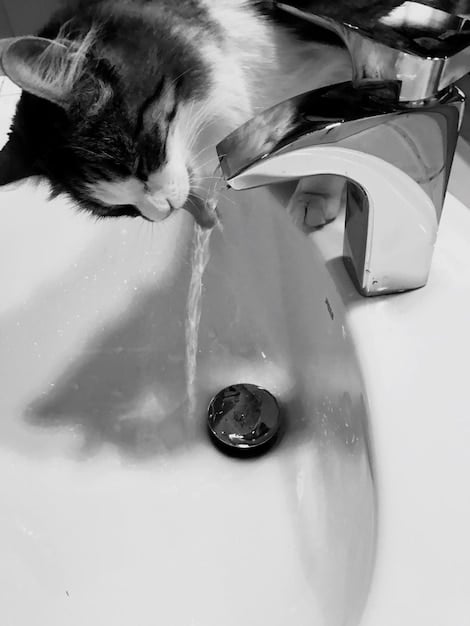
Recognizing the Signs of Dehydration
Identifying dehydration early can prevent severe health issues in your pet. Recognizing the signs of dehydration is essential for responsible pet ownership.
Subtle symptoms can quickly escalate, so proactive monitoring is key. Learn how to assess your pet’s hydration status.
Common Symptoms of Dehydration
Keep tabs on your pet’s behavior and physical condition to detect dehydration.
Performing a Simple Skin Turgor Test
A skin turgor test is a quick way to evaluate your pet’s hydration level at home.
- 👅 Sticky Gums: Dry or sticky gums are a common sign of dehydration.
- 🥺 Sunken Eyes: Dehydrated pets may have sunken eyes.
- 📉 Lethargy: A noticeable decrease in energy levels could indicate dehydration.
- ✨ Reduced Skin Elasticity: Gently pinch the skin on the back of their neck. If it doesn’t quickly snap back into place, your pet may be dehydrated.
To recap, vigilance in recognizing dehydration symptoms is essential for pet owners. Early detection can prevent serious health issues and ensure a happy, healthy life for your furry friend.
Calculating Your Pet’s Daily Water Needs
Determining how much water your pet needs daily involves considering factors like weight, activity level, and diet. Understanding your pet’s specific needs is essential for maintaining their health.
While general guidelines exist, individual requirements can vary significantly. Learn how to tailor your approach.
General Guidelines for Daily Water Intake
As a general rule calculate the amount of water for your pet
Factors Influencing Water Consumption
Several factors can either increase or decrease your pet’s daily water needs.
- 🐾 Weight: Larger pets naturally require more water than smaller ones.
- ⛹️ Activity Level: Active pets need more water to compensate for fluid loss through panting and sweating.
- 🍎 Diet: Pets on dry food diets need more water than those eating wet food, which has a higher moisture content.
- 🌡️ Environmental Conditions: Hot weather increases the demand for water as pets try to cool themselves.
In summary, calculating your pet’s daily water needs involves considering several variables. Adjust your approach to account for your pet’s unique profile and circumstances.
Tips to Encourage Your Pet to Drink More Water
Making water easily accessible and appealing can significantly boost your pet’s hydration. Simple changes can make a big difference to your pet’s water consumption.
Try various strategies to discover what works best for your furry friend. Experiment with different methods to find your pet’s preferences.
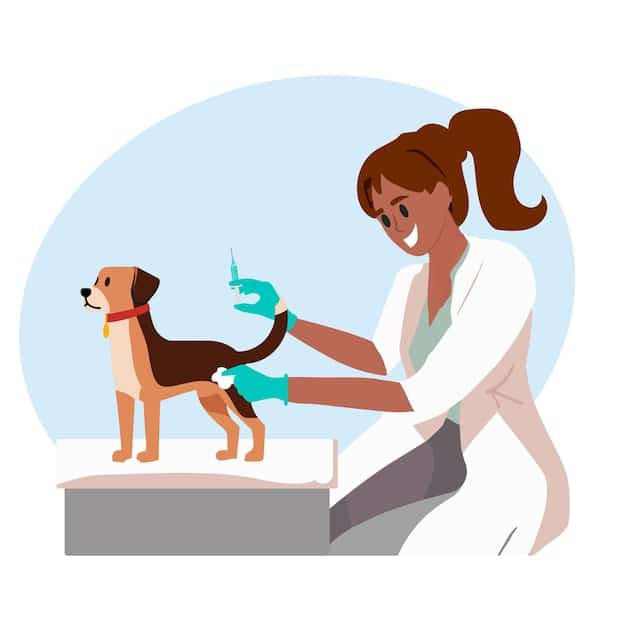
Making Water Easily Accessible
Convenience is key when encouraging your pet to drink more water; place the water where they can reach it easily.
Experimenting with Different Water Sources and Tastes
Pets, like humans, can have preferences when it comes to water, so you can try different sources and tastes.
- ⛲ Multiple Water Stations: Place bowls in different locations around your home.
- 🔄 Fresh Water: Change the water at least once a day to keep it appealing.
- 🚰 Pet Fountains: Many pets prefer drinking from running water.
- 💧 Flavor Infusions: Add a splash of low-sodium chicken or beef broth to the water bowl for added flavor.
In conclusion, encouraging your pet to drink more water can be achieved through simple, strategic changes. By understanding your pet’s preferences and habits, you can create an environment that promotes healthy hydration.
The Link Between Dehydration and Kidney Problems
Chronic dehydration can increase the risk of kidney problems in pets, particularly as they age. Knowing how the hydration is linked to kidney issues helps in preventing the pet from illness.
Understanding this connection can motivate you to take proactive steps. Learn how to mitigate the risks.
How Dehydration Affects Kidney Function
The kidneys play a crucial role in filtering waste and maintaining fluid balance.
Preventing Kidney Issues Through Proper Hydration
Adequate hydration supports optimal kidney function and reduces the risk of kidney-related diseases.
- ✨ Filtration: Proper hydration helps the kidneys efficiently filter waste products from the blood.
- ⚖️ Fluid Balance: Hydration supports the kidneys in regulating fluid and electrolyte balance.
- 🛡️ Reduced Strain: Adequate water intake reduces the workload on the kidneys, preventing overexertion.
- 🍎 Overall Health: Supporting kidney health through hydration contributes to your pet’s overall well-being.
To summarise, there is a clear link between dehydration and kidney problems in pets. By taking the time to understand and address hydration needs, you’re investing in your pet’s long-term health and well-being.
When to Consult Your Veterinarian
Knowing when to seek professional help is crucial for addressing serious dehydration or potential kidney issues. It is important to know when the situation requires a professional consultation.
When in doubt, it’s always best to err on the side of caution and seek expert advice. Trust your instincts and don’t delay seeking help.
Assessing the Severity of Dehydration
Knowing when dehydration requires immediate veterinary attention is essential.
Recognizing Signs of Kidney Problems
Knowing when to consult a veterinarian if you suspect your pet has kidney issues is essential.
- 🚨 Severe Lethargy: If your pet is unusually weak and unresponsive, seek immediate veterinary attention.
- 💔 Persistent Vomiting or Diarrhea: Prolonged vomiting or diarrhea can quickly lead to dehydration.
- 🛑 Refusal to Drink: If your pet refuses to drink water for an extended period, it’s a cause for concern.
- 🩺 Changes in Urination: Frequent urination, straining to urinate, or blood in the urine are red flags.
In conclusion, knowing when to consult your veterinarian is key to protecting your pet’s health. Don’t hesitate to seek professional advice if you have any concerns about your pet’s hydration or kidney function.
| Key Point | Brief Description |
|---|---|
| 💧 Importance of Hydration | Water is essential for temperature regulation, nutrient absorption, and organ function in pets. |
| 🩺 Recognizing Dehydration | Symptoms like sticky gums, sunken eyes, and reduced skin elasticity indicate dehydration. |
| 🍎 Calculating Water Needs | Water intake depends on weight, activity level, diet, and environmental conditions. |
| 🐾 Encouraging Hydration | Offer multiple water sources, fresh water daily, and consider pet fountains or flavored water. |
Frequently Asked Questions
▼
A general guideline is 1 ounce of water per pound of body weight daily, but it can vary based on activity level and diet. Always ensure fresh water is available.
▼
Early signs include decreased appetite, lethargy, and dry gums. Checking skin elasticity can also help determine hydration levels. Consult your vet if concerned.
▼
Yes, dry food contains minimal moisture, increasing the risk of dehydration. Supplement with wet food or ensure your pet drinks more water throughout the day.
▼
Many pets prefer running water, making fountains a great way to encourage drinking. They also keep water fresher, which can further entice your pet.
▼
If your pet refuses water for more than 24 hours, shows signs of illness, or has other dehydration symptoms, consult your veterinarian immediately for advice and treatment.
Conclusion
Ensuring your pet stays hydrated is vital for their overall health, preventing serious issues like dehydration and kidney problems. By implementing the tips and strategies discussed, you can proactively support your furry friend’s well-being and ensure they lead a happy, healthy life.

